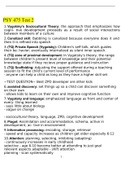Samenvatting
Media Systems in Comparative Perspective full summary 23/24
- Instelling
- Erasmus Universiteit Rotterdam (EUR)
Complete summary for MSCP (CM1008), IBCoM Year 1 Term 3. Including all exam content for year 23/24: Hallin and Mancini (2004) text book, lecture slides, and additional readings. Exam grade: 9,1; Course grade: 8,3.
[Meer zien]













